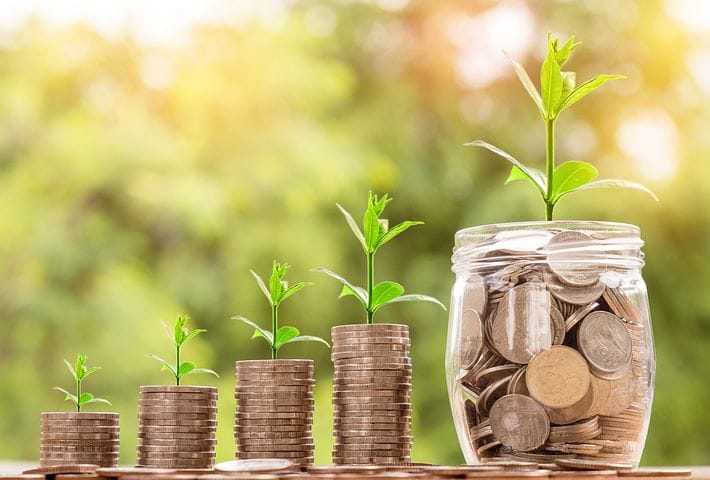Why Investing Is Better Than Leaving Money In The Bank

Are you one of those who has their savings in the bank? Do you know how much you can lose? 35% in purchasing power in 10 years. Why? Because inflation will eat your money little by little if you don’t do anything with it.
Inflation measures the evolution of the cost of living, it is calculated with the Consumer Price Index (CPI). The CPI tells us whether the basket of consumer goods and services purchased by households has become more expensive in annual terms. When it goes up, it means that life has become more expensive, that we need more money to buy the same things. And the normal thing is that the CPI rises, except for rare periods of deflation. Therefore, inflation can eat away our purchasing power if we leave our savings alone in the bank.
This is clearly explained by Borja Durán, co-founder of Finletic, in his book ‘Family Heritage Management’ . “What happens if you don’t want to invest and you keep your assets idly? Basically that one would become impoverished with the passage of time, each time they would have less purchasing power. This effect occurs due to erosion caused by inflation. Although in the short term it does not appreciate much, 3% annual inflation does not have much impact, but after only 10 years it becomes a loss of purchasing power of approximately 35%. ”
And in Business Insider they think the same. There they explain it with a practical example. Imagine that your parents had kept 1,000 euros under the mattress in 1988, 30 years ago (then 166,386 pesetas, a fortune). If today they decided to take them out they would have those same 1,000 euros, but they would be worth 147% less, which is what the IPC has risen since then.
If instead, they had managed to equalize inflation, today they would have 2,500 euros. In other words, those 2,500 euros is the equivalent money you would need to equal the initial 1,000 euros. This is how inflation literally eats your money. ”
But let’s see it graphically in a table that summarizes the effect of a 2% inflation for a person who has 10,000 starting euros and a monthly saving of 200 euros, and who was able to obtain a 3% return in different periods of time. .
Investment Is The solution
The solution so that your savings do not diminish over time is to invest them. And investing in index mutual funds is an option, yes, you should know that your money will be exposed to considerable year-on-year volatility.
Short-term investment (up to 1 year) and medium term (from 18 months to 5 years)
If you are only investing money that you are going to need soon because you want to have it on hand to pay taxes or unforeseen expenses, then you should resort to financial instruments with high liquidity, where you can withdraw your money quickly, and with low risk, since It is convenient to assume large fluctuations in the value of the investment. In exchange for the above, you will have to accept a certain risk of inflation.
Long-term investment (more than 5 years)
If you are investing your savings thinking about your retirement or the inheritance that you want to leave to your children, then the most convenient thing is that you opt for financial instruments with less liquidity because you will not need the money for a long time and you can assume greater interannual volatilities than in the short and medium term.
Long-term investments are the most important and the ones with the most complications, according to Borja Durán. There they have to compensate for inflation, costs and expenses and, therefore, “before launching to invest it is advisable to be aware of what one is going to find to prepare technically and emotionally better”. We recommend looking out for the capital value of your property in the future . You can estimate the future value of property in seconds with the house price rise calculator.
The long-term investor faces changes:
- Economic: evolution of economic cycles, variations in production factors (raw materials, energy …), globalization, inflation, interest rates, changes in currencies …
- Political: fiscal and monetary policy, wars, etc.
- Natural: natural disasters, demographic changes …
- Practical Examples: the real estate crisis, the Iraq war, the Japanese tsunami, the rise in the price of crude oil, the capitalization of banks, the drop in the American rating …
“All this kind of news is undoubtedly disturbing, even now that it is reviewed with perspective. But despite them, the world and companies have continued to grow. In another, and positive sense, it is that not all the misfortunes happen at the same time nor do they suppose the same effect in all the regions or classes of assets. For example, if global growth goes into recession it will negatively affect equities but positively on bonds.
In general, the price of any asset tends to reflect the intrinsic characteristics and expectations of generating income and capital gains. The problem arises because the variation in asset prices does not occur in a linear manner, in a continuous accrual as would be desirable, but on the contrary, in an unforeseen, rapid and forceful manner. ” Borja Durán points out: “overall, there are no investments without risk. The question is to choose what risks they can and want to take and in what proportion. “

Pranab Bhandari is an Editor of the Financial Blog “Financebuzz”. Apart from writing informative financial articles for his blog, he is a regular contributor to many national and international publications namely Tweak Your Biz, Growth Rocks ETC.







